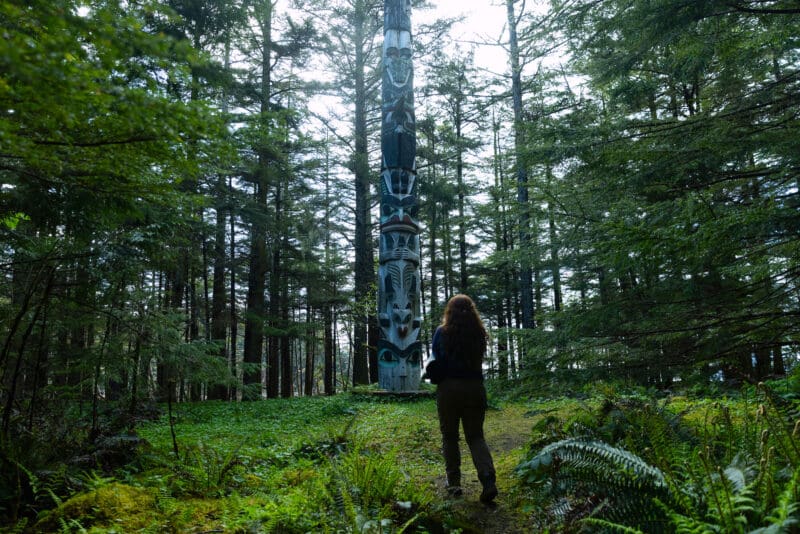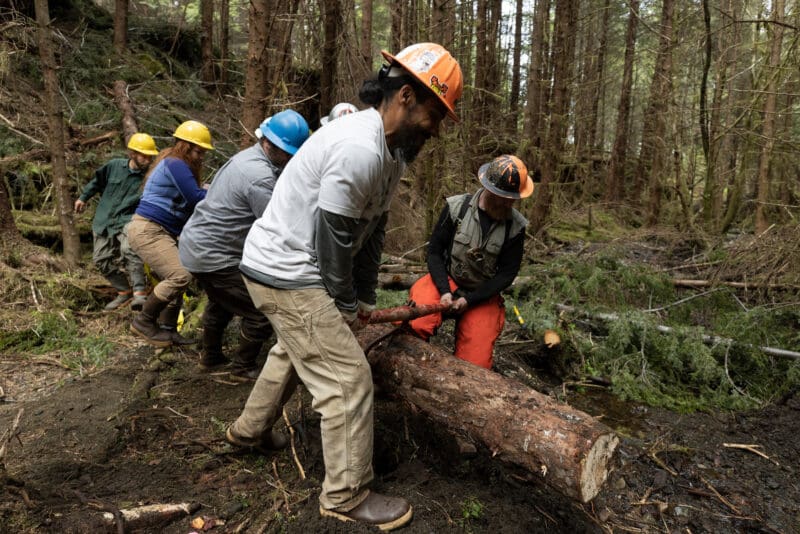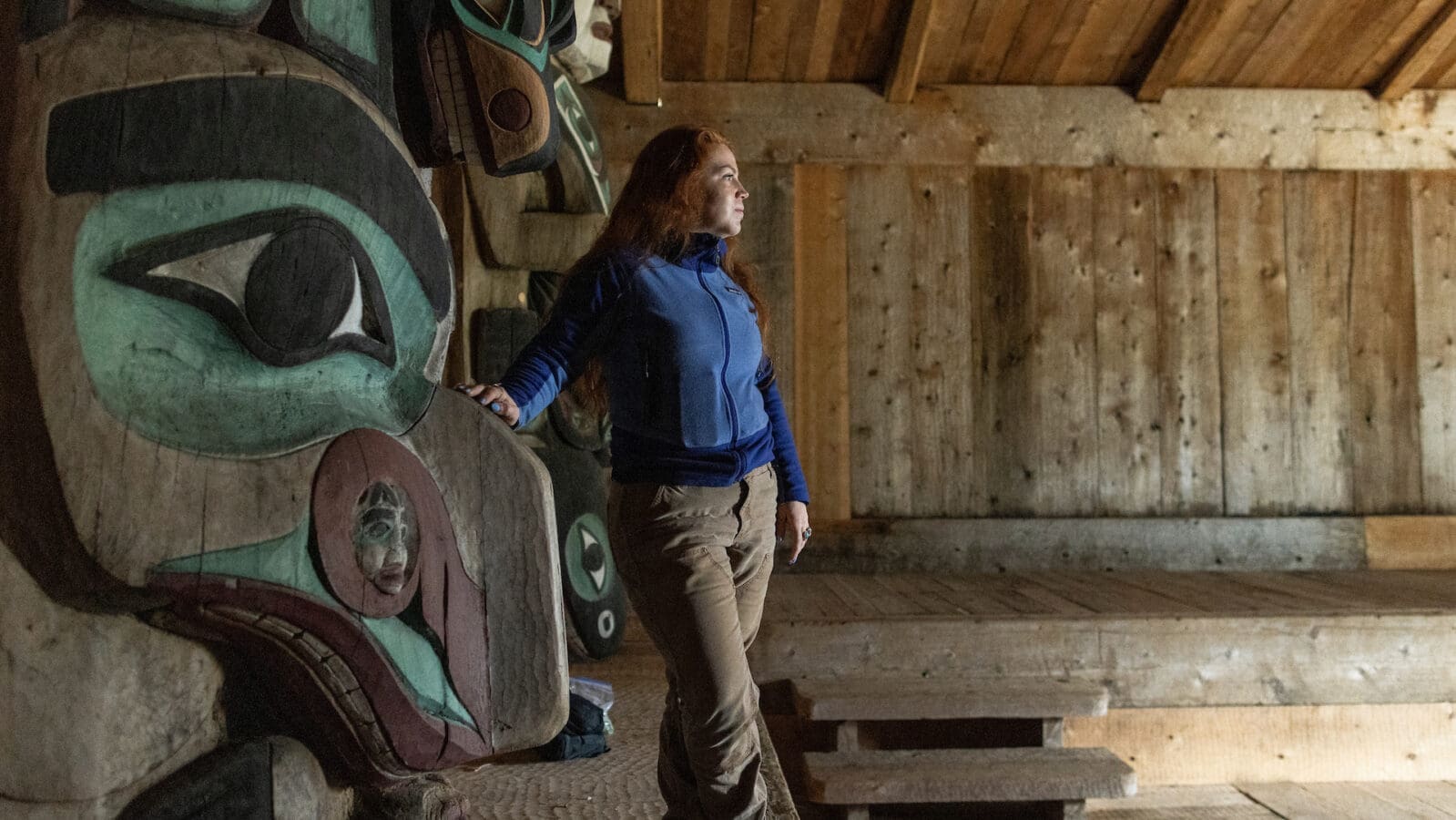Marina Anderson is a next-generation Indigenous leader building new models for community well-being and transforming the economic landscape of Southeast Alaska. As Director of the Sustainable Southeast Partnership, Marina works with a diverse network of regional leaders to build trust, catalyze change, and integrate Indigenous values and knowledge into local initiatives for regional prosperity.
Steeped in Tradition, with Eyes to the Future


Sgaahl Siid Xyáahl Jaad/Marina Anderson is deeply rooted – to her family, her land and her culture. She grew up in an old float house on the traditional lands of her people, outside of Craig in Port Saint Nicolas Bay, a narrow, barely two-mile-long indentation in the west side of Taan (also known as as Prince of Wales Island), the largest island in Alaska’s panhandle. She is Haida and Tlingit; her Haida clan is Gaw Kiiwas from Masset Inlet and Howkan, and her Tlingit clan is Taakw.aaneidi from Heenya Kwaan. Marina’s father, who worked as a heavy equipment operator for logging companies, dragged their plywood house onto the beach where they lived, though the entire verdant island could be better described as her home than the house itself. As a child she roamed the beach and forest, grazing on wild foods – blueberries, huckleberries, beach asparagus. “I just ate whatever was out there,” Marina said.
When she was young, extended family would come for visits in the summer to share in the bounty. The house would be so packed, Marina explained, you couldn’t walk through in the morning without stepping on someone’s head. Together her family harvested salmon, halibut, herring eggs, gumboot chiton, crab, octopus, berries, seaweed, and more, keeping the pressure cooker humming for weeks at a time to process the haul. Sharing, Marina said, is the central value of traditional harvesting, and her family has a 60/20/20 rule: the family gives away 60% of what they gather, preserves 20% of it for others, and reserves 20% for their own consumption and storage. This priority for community well-being is at the core of her work and life.
Marina speaks intentionally and clearly, exuding wisdom beyond her 29 years. Her rise to Indigenous leadership has been swift, though not wholly unexpected. Marina grew up learning from Elders with the Alaska Native Sisterhood, the same organization Alaska Native and civil rights leader Elizabeth Peratrovich led in the 1940s. From serving as executive assistant for the Organized Village of Kasaan to becoming the Tribe’s executive director in a matter of years and now the head of the transformative Sustainable Southeast Partnership (SSP), Marina is helping to lead a dynamic reimagining of Southeast Alaska after decades of environmental and cultural decimation driven by the logging industry. At the helm of the SSP, Marina has found a home to collaborate with committed partners and carry the momentum of sustainable place-based stewardship forward with clear vision.




Marina and the SSP are catalyzing change through a network of tribal governments, NGOs, businesses, entrepreneurs, culture-bearers, and others. “It’s not just about solving the timber problem,” she said. Instead, the SSP takes a holistic approach to challenges in the region, understanding the history that led the region to where it is today and promoting healing and a new way forward. This includes establishing the Seacoast Trust, a perpetual funding source for the SSP that is reshaping the funding structure and development of sustainable local systems and unlocking the opportunity for longer-term planning across the region.
 Southeast Alaska is, of course, dominated by the country’s largest national forest — the Tongass — a swath of forest larger than 10 U.S. states and the traditional homeland of the Tlingit, Haida, and Tsimshian peoples. The Tongass holds some of the oldest trees in the nation and is estimated to store nearly half of all the carbon held in national forests.
Southeast Alaska is, of course, dominated by the country’s largest national forest — the Tongass — a swath of forest larger than 10 U.S. states and the traditional homeland of the Tlingit, Haida, and Tsimshian peoples. The Tongass holds some of the oldest trees in the nation and is estimated to store nearly half of all the carbon held in national forests.
But where the region’s Indigenous peoples saw giant cedars that could be turned into dugout canoes, intact watersheds that grew the salmon they relied on year-round, a lush landscape that provided sustenance and medicine, and traditional fish camps and burial sites, government and industry saw lumber in board feet. Logging in the region ramped up in the 1950s, after 50-year contracts were established and locked in pulp and timber production for multiple generations. Logging companies — most with no ties to the region — clear cut millions of acres, with the bulk of the product exported to Japan.
Marina explained that a booming timber industry in Southeast Alaska meant that schools were full, community economies were chugging along, and nearly everyone had a direct connection to the logging industry — a dad or uncle or other relative employed by a timber outfit. But after generations of boom, the timber bust in the region has been near-explosive. Pulp mills that had long been anchors of the industry and communities shuttered. In less than two decades, more than 90% of timber-related jobs in the region were lost. Schools closed, and family poverty shot up. And obliteration of much of the region’s old growth forest severed crucial cultural ties. Marina witnessed firsthand the effects of the changing landscape on her community and culture, and it shapes her current work addressing the complex ecological and social challenges of Southeast communities.
"Now, we are creating a system where local youth can be part of the generation that heals the land and water,” Marina said.
Now as part of Marina’s work with the SSP, Indigenous youth are being trained to serve as stewards of the very forests their ancestors have relied on for generations and whose parents, grandparents, and great grandparents may have been hired to fell. “When I was growing up the logging industry was phasing out of supporting our communities, but I also knew I always wanted to continue to live here on my homelands. With no local work opportunities and no local education, it pushed me away for a while. Now, we are creating a system where local youth can be part of the generation that heals the land and water,” Marina said.
This collaboration is an example of systemic change that is germinating from the ground up. Creating pathways to professional opportunities, strengthening partnerships between tribes and the federal government, and sharing local knowledge with the U.S. Forest Service, helps locals and government employees feel more connected to each other and the communities and landscapes in which they work.
local knowledge with the U.S. Forest Service, helps locals and government employees feel more connected to each other and the communities and landscapes in which they work.
Reaffirming this place-based and traditional knowledge lies at the core of Marina’s work and values. She has steeped herself in her culture, learning from Indigenous tradition-bearers about traditional artistry, language, history, and ecological knowledge. Her vision for the future of Southeast is broad: she seeks to create regenerative economies, to support a region where fish swim in the rivers and giant trees stand in the forest, a place that supports healthy land, people, and communities.

Marina isn’t just envisioning the future, she’s creating it. Her advocacy and efforts to keep the Tongass roadless rule in place have catalyzed a broader movement around conservation of the Tongass. The USDA has also adopted a new strategy in the region, ending large-scale old growth logging in the Tongass and improving collaboration with tribes. Marina was one of a handful of voices that helped drive Sealaska, Southeast Alaska’s regional Alaska Native corporation, to divest from logging, instead setting aside forested acres as assets in a burgeoning carbon market. Marina’s continual commitment to step up to challenges combined with her consistent support and encouragement to others, have helped raise up a new cohort of young Indigenous leaders in Southeast Alaska.
Marina is magnetic and authentic. She is just as likely to be taking a cold plunge in the ocean or pickling elderberries as talking to national audiences about climate and the deep connection between communities and the forest. Marina’s been nationally recognized at venues like the esteemed Aspen Festival, White House events for young Indigenous leaders, and with a 2023 Ecotrust Indigenous Leadership Award for her dedication to her homeland and community.


Despite her many commitments, Marina’s year revolves around traditional harvests — both the opportunities those bring and the responsibilities. The year starts with the harvest of herring eggs, which is followed by seaweed, devil’s club, fiddleheads, beach greens, and on and on. Her Instagram feed is a mouth-watering photo montage of her way of life — gleaming, freshly harvested salmon filets; ruby red smoked salmon strips; local shrimp gifted by an Elder; golden chicken of the woods mushrooms packed into canning jars; and buckets filled with bright green spruce tips. Marina tells the story of a vibrant life that depends on healthy waters and lands.
Even before stocking her own freezer with fish and deer, Marina ensures the Elders around her are fed and their own pantries are stocked. And sharing her knowledge — how to harvest, how to put up food — is central to her calendar as well. “That’s really important to me,” she said. She’s taught others how to smoke fish, how to put up deer through pressure-cooking in glass jars, how to make medicine out of local plants. Marina knows how to make change, one jar of salmon, one shared meal, one policy at a time.
Alaska Venture Fund supports Sustainable Southeast Partnership’s work to develop a regenerative economy and ensure Southeast Alaska thrives for future generations. You can find more information about the program and mission by clicking here or connect with Marina Anderson directly at marina@spruceroot.org
Words by Miranda Weiss. Miranda is a science and nature writer and the author of ‘Tide, Feather, Snow: A Life in Alaska’. Her work has appeared in The Washington Post, The Economist, The American Scholar, Alaska Dispatch News and elsewhere. She lives with her family in Homer.
Photos by Nathaniel Wilder. Nathaniel specializes in editorial and environmental visual storytelling. His editorial work has appeared in the New York Times, Smithsonian Magazine, National Geographic Proof, Outside Magazine, Grist, Oprah Magazine, Runner’s World Magazine, and Patagonia’s Cleanest Line Blog.
Published October 24, 2023
